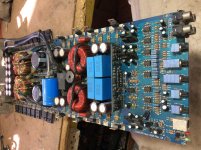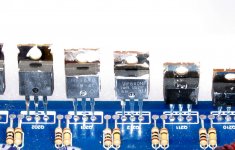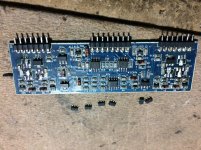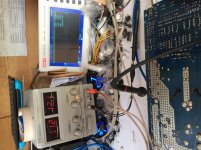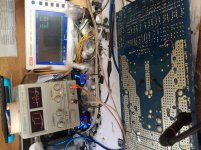What's up guys, I'm seeking some information on the output mosfets for this amp particularly the insertion arrangement.
It was started by another person but they pulled the outputs and I think they got it mixed up, so far I see the amps uses 640s and 9640s (the "s" is for plurality).
It's 5 pieces per rail on one side (10 pieces for complete rail plus/minus), what fets do I insert on the positive rail and what fets for the minus rail?
It was started by another person but they pulled the outputs and I think they got it mixed up, so far I see the amps uses 640s and 9640s (the "s" is for plurality).
It's 5 pieces per rail on one side (10 pieces for complete rail plus/minus), what fets do I insert on the positive rail and what fets for the minus rail?
Attachments
Generally, the layout on the board tells you N or P channel (or NPN/PNP). The N generally has a hollow outline. The P has a filled outline.
P-channel goes on the positive rail. N-channel goes on the negative rail.
See attached.
P-channel goes on the positive rail. N-channel goes on the negative rail.
See attached.
Attachments
The audio driver board is giving some issues, the amp is making a squealing sound (even without input audio) with the output fets getting hot. I think I want to rebuild the board before I reinstall it, does anyone knows the part number for Q18 and Q14 and R24 and the U2 and U3 scratches off IC's and if there are any known parts that's likely to fail on these board?
Attachments
Last edited:
Q7, 11, 19 and 22 along the top of the board fail, most commonly. The 470 ohm resistors between those transistors and the drivers also fail regularly.
U2, tl-072
U3, LM211
180 ohms
mmbt3904 (Q14), mmbt3906
U2, tl-072
U3, LM211
180 ohms
mmbt3904 (Q14), mmbt3906
Last edited:
I’ve rebuilt the driver board and replaced the four rail caps in the power supply but the amp is only sinking my power supply voltages (approx 6v and drawing all available amperage also 6amp max) from 12v when I try to power it on.
It goes from protect to power and the relay engages. If left on you’d feel the outputs begin to get between hot minus and warm plus. I’m only using 8 fets (4p and 4n) out of 20 pcs.
However, when I remove the all the fets and add source audio I’m getting clean low and high side drive higher rail voltage (71+/-) and it doesn’t drag my bench PSU.
Is it that I don’t have enough amperage to boot this amplifier or I have to load all the output for it to operate properly? (Which I think would need more amperage).
It goes from protect to power and the relay engages. If left on you’d feel the outputs begin to get between hot minus and warm plus. I’m only using 8 fets (4p and 4n) out of 20 pcs.
However, when I remove the all the fets and add source audio I’m getting clean low and high side drive higher rail voltage (71+/-) and it doesn’t drag my bench PSU.
Is it that I don’t have enough amperage to boot this amplifier or I have to load all the output for it to operate properly? (Which I think would need more amperage).
Attachments
Load the FET locations (no FETs installed) with a small capacitor to see how the drive does with a load.
Something near 0.01uF.
Load gate to source on one FET location in each bank. You can check one bank at a time
Load gate to source on one FET location in each bank. You can check one bank at a time
I’m just curious as in how severe or catastrophic loading the fets opposing the circuit board legends (part placement marker), as in N’s load were P’s should be on the output side of the circuit, would it produce audio (in any form)?
Or would the fets blowout? Bear in mind a small power supply not exceeding 5-6amp.
Or would the fets blowout? Bear in mind a small power supply not exceeding 5-6amp.
If you're asking what would happen if you installed the FETs in the wrong locations, I'd expect excessive current draw. I doubt that there would be any damage with 6 amps of current (assuming that you didn't let it stay on too long).
If the FETs were in locations (reversed polarity) as I understood it, I think it would have simply drawn excessive current.
- Home
- General Interest
- Car Audio
- Carbon CB2200.1 or similar
